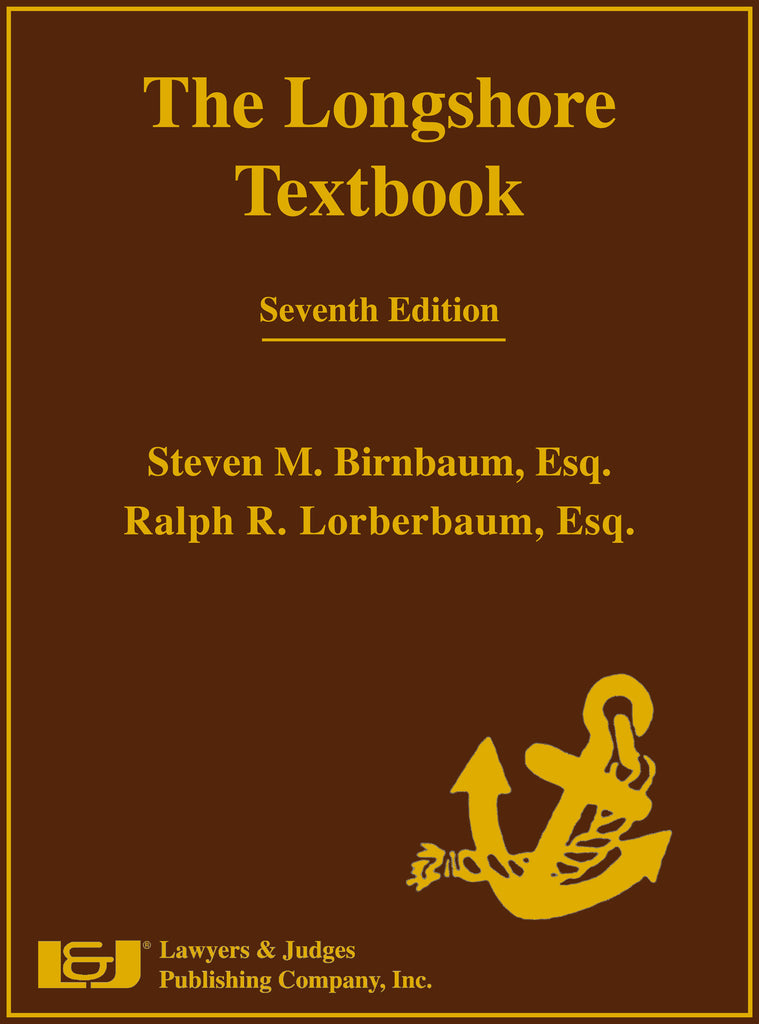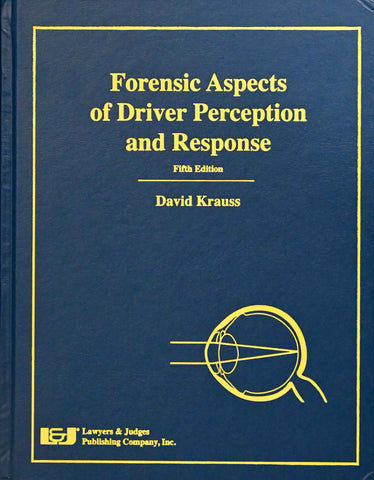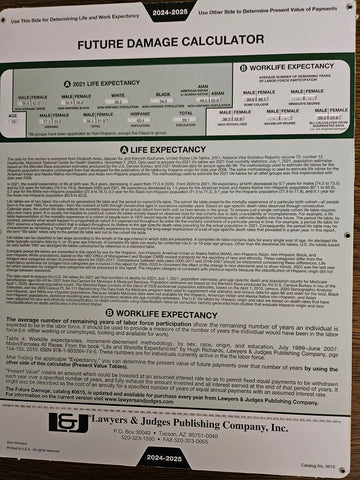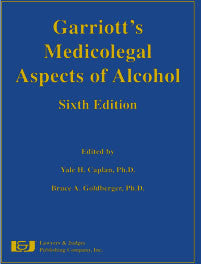
The Longshore Textbook, Seventh Edition
- Compilers: Steven M. Birnbaum Esq., Ralph R. Lorberbaum Esq. Contributors: Hon. Stephen R. Henley, David Barnett, Esq., D.A. Bass-Frazier, Esq., Alan G. Brackett, Esq., Norman Cole, Esq., Paul M. Doolittle, Esq., Eric A. Dupree, Esq., Kenneth G. Engerrand, Esq., Thomas C. Fitzhugh III, Esq., Lewis S. Fleishman, Esq., Keith L. Flicker, Esq., Jess Ghannam, Ph.D., Joshua T. Gillelan II, Esq., Howard S. Grossman, Esq., Alexandra E. Grover, Esq., Joseph B. Guilbeau, Esq., Paul B. Howell, Esq., Frank B. Hugg, Esq., John F. Karpousis, Esq., Robert Kessner, Esq., Roger A. Levy, Esq., Monica F. Markovich, Esq., Kris R. Marotti, Esq., Brian P. McElreath, Esq., Robert A. McLaughlin, Esq., Michael P. McQuinn, Esq., Lara D. Merrigan, Esq., Amie C. Peters, Esq., Charles Robinowitz, Esq., Bobbi N. Roquemore, Esq., Collins C. Rossi, Esq., John L. Schouest, Esq., Scott L. Thaler, Esq., Michael W. Thomas, Esq., Ruth Bennett Whitfield, Esq., Jeffrey Winter, Esq.
- Copyright Date Ed: July 25, 2017
- ISBN 10: 1-936360-86-1
- ISBN 13: 978-1-936360-86-4
- Publisher: Lawyers & Judges Publishing Company
- Pages: 352
- Binding Information: casebound
- Size: 8.5 × 11 Inches (US)
"The Longshore Textbook is an outstanding publication." -- Marine Index Bureau Update, 01/01/1991
"...thoroughly explains employee benefits and rights. No rehabilitation counselor working with Longshore clientele should be without it." -- Winkler Rehabilitation Associates, 05/13/1996
Extensively revised and rewritten, this text is a must for any professional involved with Longshore and Harbor Workers' compensation claims.
The seventh edition of The Longshore Textbook contains the full text of the Longshore Act, and the applicable portions of the Code of Federal Regulations-to-date as well as analyses of current court decisions and has been expanded with new and revised chapters, making it a must for your reference library. Long recognized as "the single source" reference guide for attorneys, adjusters, physicians, vocational counselors, and insurance professionals, this newly revised seventh edition is the most complete publication of its kind.
Experts in law, medicine, and administration present an easy-to-read explanation of the Longshore Act. You will appreciate the clear concise manner in which the Act is evaluated and examined, supplying you with careful presentations of court decisions affecting its application. Legal decisions, statutes, and regulations are liberally cited throughout. Its treatment includes issues such as disability, occupational disease, coverage, situs and status, benefits, industrial psychiatric injuries, HIPAA, vocational rehabilitation, employer’s liability, ethical considerations, third party provisions, the NAFI, the zone of special danger, the Price case, and more. Practical questions are also addressed: file administration, administrative procedures, calculating wages, trial practice, appeals before the Benefits Review Board, mediation, jurisdictional issues, and more.
Supplementing the substantive materials are the texts of the Longshore Act, the applicable portions of the Code of Federal Regulations, interest and benefit tables, samples of commonly used forms, a current directory of Department of Labor Longshore offices, and a detailed index and table of cited cases.
Thousands of professionals use the previous editions of The Longshore Textbook. This newly revised seventh edition, the most complete single source publication yet, should be part of your professional library.
Table of Contents
Part I: Defining Coverage and Its Issues
Chapter 1: Concurrent Jurisdiction
By Kenneth G. Engerrand, Esq.
1.1 Summary
1.2 Statutory Bases
1.3 Introduction
1.4 LHWCA and State Workers’ Compensation Acts
1.5 LHWCA and Jones Act
1.6 Other Remedies
1.7 Conclusion
Chapter 2: Situs and Status Coverage and Jurisdiction Under the Longshore and Harborworkers’ Compensation Act
By John F. Karpousis, Esq.
2.1 Background
A. Status
1. The key Supreme Court cases on “status”
2. Recent cases regarding terminal workers and status
3. Harborworkers: a special analysis
B. Situs
C. A Word About Bridge Workers
2.2 Conclusion
Chapter 3: Unique Aspects of the Nonappropriated Fund Instrumentalities Act
By Ruth Bennett Whitfield, Esq.
3.1 NAFI Employees
A. Diverse Workforce and Employment
B. Unique Job Retention and Leave Benefits
C. Non-Citizen and Non-Resident Employees
D. Volunteers
E. Only Civilian Workers Covered
3.2 Course and Scope of Employment
A. Parking Lot Claims
3.3 Exclusive Remedy
A. NAFI Employees Not Covered by the DBA
3.4 Minimum Compensation Rate
3.5 Anti-Alienation of Benefits
3.6 Appellate Jurisdiction
3.7 Representation
Endnotes
Chapter 4: The Defense Base Act and War Hazards Compensation Act
By Roger A. Levy, Esq.
4.1 The Defense Base Act (“DBA”)
A. Coverage
B. LHWCA vs. DBA—Vive La Difference!
1. American and Canadian vs. other foreign residents—42 USC 1652(b)
2. Computation of benefits on account of injury or death
C. Zone of Special Danger
4.2 The War Hazards Compensation Act (“WHCA”)
A. Coverage
B. War Risk Hazard
C. Reimbursement
D. Direct Payments by DFEC
Chapter 5: The Zone of Special Danger
When a Claim Arises in the Course and Scope of Employment Under the Longshore Act and Its Extensions
By Lewis S. Fleishman, Esq. and Lara D. Merrigan, Esq.
5.1 The Positional-Risk Doctrine and the Zone of Special Danger
5.2 The Positional-Risk Doctrine Under the Defense Base Act: The Zone of Special Danger Outside of Working Hours
5.3 The Outer Limits of Defense Base Act Coverage: “Chutzpah Claims”
5.4 “Boys Will Be Boys” and “Girls Will Be Girls”: Accepted Human Behavior Within the Zone
5.5 The Applicability of the Zone of Special Danger to Longshore Act Claims Beyond the Defense Base Act
5.6 Conclusion
Chapter 6: Price and the Bright, Fuzzy Line of Traumatic Two-Injury and Cumulative Orthopedic Claims
By Frank B. Hugg, Esq.
6.1 The Price Rule Restated: The Last Employer Buys the Farm?
6.2 The Origins and Development of the Two-Employer Rule
6.3 Price Two-Employer Rule Applied
6.4 Post-Price: The Ninth, Other Circuits, and the Board
6.5 Conclusion: Price—The New is Old Rule For Evidence
Part II: Medical Treatment
Chapter 7: The Health Insurance Portability and Accountability Act of 1996 & The Longshore and Harbor Workers’ Compensation Act
By Robert Kessner, Esq & Robert A. McLaughlin, Esq.
7.1 Background
7.2 The Privacy Rule
A. General Rules for Use and Disclosure of Protected Health Information—45 CFR § 164.502 General rule. 45 CFR § 164.502(a)
B. Minimum Necessary—45 CFR § 164.502(b)
7.3 Uses and Disclosures Permitted by the Privacy Rule—45 CFR §§ 164.512 & 164.508
A. Uses and Disclosures Required by Law—45 CFR § 164.512(a)
B. Disclosures for Workers’ Compensation—45 CFR § 164.512(l)
C. Uses and Disclosures for Judicial and Administrative Proceedings—45 CFR § 164.512(e)
1. In response to an order of a court or administrative tribunal—45 CFR § 164.512(e)(1)(i)
2. In response to a subpoena, discovery request or other lawful process—45 CFR § 164.512(e)(1)(ii)
D. Disclosures in Which an Authorization Has Been Provided—45 CFR § 164.508
7.4 Ex Parte Communication Between Representatives of the Carrier and Claimant’s Treating Physician
7.5 Implications of the Privacy Rule on the Handling of Workers’ Compensation Claims
Endnotes
Chapter 8: Medical Treatment
By Ralph R. Lorberbaum, Esq.
Endnotes
Chapter 9: New Frontiers in Industrial Psychiatric Injuries
By Jess Ghannam, Ph.D.
9.1 Posttraumatic Stress Disorder, Complex Posttraumatic Stress Disorder, Traumatic Brain Injury, and Post Concussive Syndrome
9.2 Cultural Factors, Reflections, and Recommendations
9.3 Checklist
References
Part III: Compensation
Chapter 10: Compensation Rates and Cost of Living Adjustments Under the LHWCA
By Joseph B. Guilbeau, Esq.
10.1 Overview
10.2 Primary Statutory Provisions
10.3 Discussion of Compensation Rates Including Maximum and Minimum Rates
10.4 §906 Max/Min Rates and AWW Adjustments
10.5 §10(f) COLA and §6(c) Increases Overlap but Operate Independently
Endnotes
Chapter 11: Average Weekly Wage Calculations & Per Diem Considerations
By Brian P. McElreath, Esq.
11.1 Introduction
11.2 Basic AWW Considerations
11.3 Section 10(a) & (b) AWW Calculations
11.4 Section 10(c) AWW Calculation
11.5 DBA AWW Calculations
11.6 Per Diem Considerations
11.7 Acknowledgements
Endnotes
Chapter 12: Calculation of the Average Weekly Wage Under the Defense Base Act
By Monica F. Markovich, Esq.
12.1 Wages
12.2 Section 10(a)
12.3 Section 10(b)
12.4 Section 10(c)
12.5 Section 10(i)
12.6 DBA Indemnity Benefits: Trends But Still No Consensus
Acknowledgements
Chapter 13: Scheduled Injuries Versus Unscheduled Injuries Under the Act
By Paul B. Howell, Esq.
Chapter 14: The Difference Between Temporary Total, Temporary Partial, Permanent Partial, and Permanent Total Disability
By Alan G. Brackett, Esq.
Endnotes
Chapter 15: Limiting Employers’ Liability
By Michael W. Thomas, Esq. and Michael P. McQuinn, Esq.
15.1 Introduction
15.2 Credit for Payments Received by Claimant from Prior Awards, Alternate Sources, and Advance Payment Under the Act
15.3 Credit for Workers’ Compensation and Jones Act
15.4 Credit for Advance Payments of Compensation
15.5 Independent Credit Doctrine
15.6 Credit for Third-party Lawsuit Recoveries
15.7 Section 8(f)—Limitation of Liability
15.8 New Injury
15.9 Pre-Existing Permanent Partial Disability
15.10 Manifest to the Employer Before the New Injury
15.11 Disability Not Due Solely to the New Injury
15.12 Disability is Materially and Substantially Greater: The Contribution Element
15.13 Procedural Pitfalls and the Catch
Endnotes
Chapter 16: Death Benefits Under the Longshore & Harbor Worker’s Act
By Howard S. Grossman, Esq. and Scott L. Thaler, Esq.
16.1 Introduction
16.2 Providing Timely Notice of Death §12
16.3 Initiating the Process to Obtain Death Benefits With the Office of Workers’ Compensation Programs
A. Timeliness of Filing a Claim for Death Benefits Under §13(A) of the Act
B. §20(b) Presumption
C. What Constitutes Prejudice?
16.4 Who is Entitled to Receive Death Benefits?
A. Status as “Widow” or “Widower”
B. What Constitutes Living Apart for Justifiable Cause or by Reason of Desertion
1. Living apart: test is partial dependency
C. Children Under §2(14)
1. Dependent children of the decedent at the time of death
D. Grandchild
E. Brothers and Sisters
F. Parent
G. Alien Non-Residents of the United States or Canada
16.5 Computation of Death Benefits Award
16.6 Commutation of Death Benefits
16.7 There is Only One Death Benefit Even if there are Multiple Surviving Beneficiaries
16.8 Compensability of Death
A. What Constitutes a Causal Connection Between the Work Injury and Occupational Illness?
B. Suicide is it a Bar to Recovery of Death Benefits?
16.9 Alcohol Intoxication
Endnotes
Part IV: Process at the OWCP
Chapter 17: Administrative Claims Handling at the District Director’s Office
By Thomas C. Fitzhugh III, Esq.
Chapter 18: Discrimination
By Norman Cole, Esq.
18.1 Statute and Administrative Rule
18.2 Scope of §48a Discrimination
18.3 Burden of Proof
18.4 Discriminatory Act
18.5 Animus—A Discriminatory Intent
18.6 Discrimination is an Uninsured Liability
18.7 Remedies
18.8 Limitations
Chapter 19: Uses and Abuses of the Section 20 Presumptions
By John L. Schouest, Esq., Bobbi N. Roquemore, Esq., and D. A. Bass-Frazier, Esq.
19.1 The Employer’s Point of View
A. Introduction
B. How the Section 20(a) Presumption is Used
C. How the Section 20(a) Presumption Cannot be Used
D. How the Section 20(a) Presumption is Abused
E. Additional Presumptions under Section 20, and Their Uses and Abuses
1. Section 20(b): Notice
2. Section 20(c): Intoxication
3. Section 20(d): Willful Intent to Injure Self
F. Conclusion
References
19.2 The Claimant’s Point of View
A. If the ALJ Totally Discredits the Claimant’s Testimony, then Objective Medical Testimony Based Upon the Claimant’s Subjective Complaints Can Not Meet the Prima Facie Standard
B. Finding that an Injured Worker with a Low Mental Capacity Gave Inconsistent Testimony Justifies Denying the Claim
C. The Presumption Applies to Determine the Last Responsible Employer/Carrier
D. Proving a Physical Injury or that the Injured Worker was Within “The Zone Of Danger” is Not Required to Establish the Prima Facie Claim for a Compensable Psychological Injury
E. Even Though it Happened at Work, a Cross-dresser’s Death By Asphyxiation was Not a Compensable Injury
F. A 400 Pound 60-year-old with a History of Back Injuries Can Prove a Prima Facie Claim for Compensability After Being Assigned to Physically Strenuous Work Activity
G. Testimony of a Recently Demoted Employer that Had Threatened to Have a Work-Related Injury was Not Credible and the Claim Was Denied
H. Claimant With a 0.25 BAC that Had Actively Participated in Beer-Thirty from Before Work Until the End of the Day Did Not Prove that the Cement Ledge Whereupon He Landed Caused His Injury
I. If You Do Not Claim It, the Court Shall Not Award It
J. Every Medical Development that Happens After an Injury is Not Automatically Compensable
K. Working for Another Employer a Mere Nine Days After an ACL Tear Can Leave it as the Responsible Employer
L. Working Conditions that Could Cause Asbestosis Supported the Finding that as a Matter of Law the Death Was Work-Related
M. Medical Evidence of a Stroke Occurring After a Legitimate Personnel Change Does Not Meet the Causal Relationship Element
N. Same Employer Expert, Same Opinions, Different Outcomes
Endnotes
Part V: Trial at the OALJ
Chapter 20: Practice before the Office of Administrative Law Judges
By Hon. Stephen R. Henley
20.1 Introduction: General Background Information
20.2 Implementing Authority and Creation of the Office of Administrative Law Judges
20.3 The Claim Process
20.4 Subpoenas
20.5 The Transfer of Claims to the OALJ
20.6 The OALJ Hearing Process
20.7 Parties and Representatives
20.8 Setting Hearings
20.9 Section 8(i)—Settlement of Claims
20.10 Service, Format, and Timing of Motions and Other Papers
20.11 Disclosure and Discovery
20.12 Evidence and Witnesses
20.13 Conduct of the Hearing
20.14 ALJs’ Authority to Regulate Conduct of Adjudication Proceedings; Sanctions
20.15 Decision and Order
20.16 Motions for Reconsideration
20.17 Resources
20.18 Closing
Chapter 21: Mediating Cases Brought Pursuant to the LHWCA and its Extensions
By Roger A. Levy, Esq., Paul M. Doolittle, Esq., and Collins C. Rossi, Esq.
21.1 Introduction
21.2 Ethics for Mediators
A. Conflict of Interest (Model Standards of Conduct Sec. III)
B. Competence (Model Standards of Conduct Sec. IV)
C. Impartiality (Model Standards of Conduct Sec. II)
D. Voluntariness or Self Determination (Model Standards of Conduct Sec. I)
E. Confidentiality (Model Standards of Conduct Sec. V)
F. Informed Consent and Quality of the Process (Model Standards of Conduct Sec. 6)
G. Advertising and Solicitation (Model Standards of Conduct Sec. VII) and Fees (Model Standards of Conduct Sec. VIII)
H. Obligations to the Mediation Process Mediators have a Duty to Improve the Practice of Mediation (Model Standards of Conduct Sec. 9)
21.3 Being Prepared for Mediation
Appendix A
Appendix B
21.4 Negotiations and Mediation
A. When to Mediate
B. Mediation Preparation
C. Finally—At the Mediation
D. Extras
E. Alternate Resolutions
Chapter 22: Trial: Witnesses & Discovery
By Alexandra E. Grover, Esq., Jeffrey Winter, Esq., and David Barnett, Esq.
22.1 The First Day of Trial: The Initial Interview
22.2 The Second Day of Trial: What Evidence is Missing?
A. Fact Witnesses
B. Expert Witnesses
22.3 The Third Day of Trial: Piecing Together the Puzzle Through Formal and Informal Discovery
A. Initial Disclosures
B. Formal Discovery
C. Obtaining Documentary Evidence
1. From claimant or client
2. From employer/carrier
3. From doctors
4. From the DOL
5. From the district director or regional solicitor
6. From the internet
D. Enforcing the Discovery Rules
22.4 The Fourth Day of Trial: Making Sense of It All
22.5 The Fifth Day of Trial: Preparing Your Witnesses
A. Preparing the Claimant
B. Meeting with Percipient Witnesses
C. Meeting with the Experts
22.6 The Sixth Day of Trial: Putting on Your Case
22.7 The Seventh Day of Trial: The Post Trial Brief
Chapter 23: Ethical Considerations in Longshore Practice
By Keith L. Flicker, Esq.
Chapter 24: Attorney Fees
Revised and updated by Charles Robinowitz, Esq. from the chapter in 2010 by Eric A. Dupree, Esq., Joshua T. Gillelan II, Esq., and Charles Robinowitz, Esq.
24.1 Conditions for Employer Fee Liability
24.2 The Application for Attorney Fees and Costs
24.3 Amount of Fees and Expenses Recoverable
24.4 Market Rates
A. Rules in Deciding Fee Awards
B. Effect of Delay on Market Rates
C. Compensable Services
D. Recoverable Expenses
24.5 Appellate Review
Endnotes
Part VI: Appellate Practice
Chapter 25: Appellate Procedure Under the Longshore Act
Joshua T. Gillelan II, Esq., Kris R. Marotti, Esq., and Lara D. Merrigan, Esq.
25.1 Basic Appellate Framework
25.2 Reviewable Decisions
A. District Directors’ Decisions
B. ALJs’ Decisions
C. Benefits Review Board Decisions
D. Stays of Payment Pending Review
25.3 Scope of Review
A. Factual Disputes
B. Questions of Law
25.4 Petition for Review to the Benefits Review Board
A. Notice of Appeal Form and Contents
B. Notice of Appeal Timeliness
C. Briefing
D. Electronic Filing with the Board
E. Oral Argument
F. Decision and Reconsideration
G. Attorney Fees
25.5 Petition for Review to the Court of Appeals
A. Admission to the Circuit Court Bar
B. Filing Petition
C. Timeliness
D. Briefing
1. The petitioner’s brief
2. The respondent’s brief
3. Reply brief
4. Amicus brief and cross appeals
5. Supplementing the brief
6. Request for oral argument
E. Oral Argument
F. Decision, Rehearing, and Mandate
G. Fee Applications in Circuit Court Appeals
Endnotes
Part VII: Resources
Chapter 26: Online Resources for the Longshore Practitioner
By Amie C. Peters, Esq.
26.1 U.S. Department of Labor Resources
A. The Office of Workers’ Compensation Program—Division of Longshore & Harbor Workers (DLHWC)
B. Office of Administrative Law Judges (OALJ)
C. Benefits Review Board (BRB)
26.2 Legal Research Sites
26.3 Online Evidence
Appendix A: Longshore and Harbor Workers’ Compensation Act and its Extensions
Appendix B: Code of Federal Regulations
Subchapter A—Longshoremen’s and Harbor Workers’ Compensation Act and Related Statutes
Part 701—General; Administering Agency; Definitions and Use of Terms
Part 702—Administration and Procedure
Subpart A—General Provisions
Subpart B—Claims Procedures
Subpart C—Adjudication Procedures
Subpart D—Medical Care and Supervision
Subpart E—Vocational Rehabilitation
Subpart F—Occupational Disease Which Does Not Immediately Result in Death or Disability
Part 703—Insurance Regulations
Part 704—Special Provisions for LHWCA Extensions
Part 801—Establishment and Operation of the Board
Part 802—Rules of Practice and Procedure
Subpart A—General Provisions
Subpart B—Prereview Procedures
Subpart C—Procedure for Review
Subpart D—Completion of Board Review
Part 18—Rules of Practice and Procedure for Administrative Hearings Before the Office of Administrative Law Judges
Subpart A—General
Index to the Code of Federal Regulations
About the Authors
About the Contributors
Index



